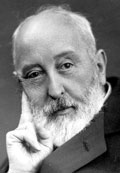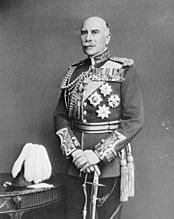Governor-general facts for kids

A governor-general is a special official who represents a monarch (a king or queen) in a country where the monarch does not usually live. Think of them as the monarch's stand-in or representative. This role is often found in countries that used to be part of the British Empire and are now independent but still have the British monarch as their head of state.
Contents
Where are Governors-General Today?
Today, the title of governor-general is mostly used in countries called Commonwealth realms. These are independent nations that recognize the British monarch as their head of state. Before World War I, this title was mainly used in big, self-governing British colonies like Canada, Australia, and South Africa. These places already had "governors" in their smaller parts, so the main representative got the higher title of "governor-general." New Zealand also got a governor-general in 1917.
Since the 1950s, as more British colonies became independent, their colonial governors often became governors-general. This showed that they were no longer just symbols of British rule. Instead, they became independent representatives of the monarch in their own country. In these nations, the governor-general performs many important jobs, like ceremonial duties and constitutional tasks, similar to a head of state.
The only other country that uses a similar title is Iran. There, a "governor general" (called ostāndār) leads each province. This role is different from the Commonwealth ones and has no connection to a monarchy.
Governors-General in the British Empire

For a long time, until the 1920s, governors-general were British citizens. The British government chose them. They acted as representatives of the British government in each Dominion (a self-governing territory). They also represented the monarch. They had a lot of power, including the monarch's special powers and the executive power of the country they were in.
The British government could tell the governor-general what to do, like whether to approve new laws. History shows many times when governors-general used their powers. The monarch or the British government could overrule a governor-general, but this was often hard because the territories were far from London.
The governor-general was also usually the leader of the armed forces in their territory. Because they controlled the military, the job was both a military and a civil one. Governors-general used to wear a special uniform, but this is not common today.
Past Governors-General in the British Empire
The Modern Commonwealth Role
After a big meeting in 1926, the job of the governor-general started to change. This reflected that the Dominions were becoming more independent. The monarch was now seen as the king or queen of each country separately. The monarch would only take advice from the ministers of that specific country. This meant the governor-general became a direct representative of the monarch of that nation. They no longer answered to the British government.
This idea was made into law with the Statute of Westminster 1931. It made it clear that countries like Canada, Australia, and New Zealand were not controlled by the United Kingdom. Today, the monarch of these countries, Charles III, is legally the King of Canada, King of Australia, and King of New Zealand. He acts only on the advice of the ministers in each country.
So, in independent Commonwealth realms, the governor-general represents the monarch. They can use the monarch's special powers, but usually only on the advice of the country's prime minister. The governor-general still takes an oath of allegiance to the monarch of their own country.
At official events, people toast "The King" or "The Queen" of the country, not the governor-general. Any mention of the governor-general comes later and is usually by name.
Usually, the governor-general follows the country's customs and acts on the advice of the prime minister. Their role is mostly ceremonial. However, there have been rare times when a governor-general took strong action. For example, in 1975, the governor-general of Australia, Sir John Kerr, dismissed the prime minister. Even though they don't often take drastic steps, governors-general must make sure the country's constitution is always followed. They often act like an umpire, staying neutral and fair in politics.
In Australia, people sometimes debate whether the monarch or the governor-general is the true head of state. This is because the governor-general does almost all the royal duties in the country.
A governor-general is usually someone who has done great public service. They might be a retired politician, a judge, or a military leader. Sometimes, they are academics, religious leaders, or people known for charity work.
The official home of a governor-general is usually called Government House. For example, the governor-general of the Irish Free State lived in the Viceregal Lodge in Dublin.
The flag of a governor-general usually has a blue background with the Royal Crest (a lion on a crown). Some countries have unique designs. For example, Canada's flag has a crowned lion holding a maple leaf.
Governors-general and their spouses are given the special title of Their Excellency.
How are Governors-General Chosen?

Before the 1920s, the British government chose governors-general. But in 1929, the Australian prime minister, James Scullin, insisted that he should advise the monarch directly on who to appoint. He wanted an Australian, Isaac Isaacs, for the job. This led to a new rule: the governor-general should be a citizen of the country they serve. They are appointed on the advice of that country's government, with no input from the British government.
Since 1931, as each former Dominion gained more control over its own laws, this rule became law. The monarch appoints a governor-general only on the advice of the prime minister of that specific country. For example, the King of New Zealand appoints the governor-general of New Zealand based on the New Zealand prime minister's advice. In Papua New Guinea and the Solomon Islands, the prime minister's advice comes from a vote in their national parliament.
The exact steps for appointing governors-general can differ slightly between countries. For instance, in Australia, the governor-general issues a special announcement after being appointed. In Canada, the governor general's appointment includes their role as commander-in-chief of the armed forces. Also, the powers of governors-general are not exactly the same everywhere.
Commonwealth Countries with a Governor-General
Temporary Replacement
If a governor-general dies, resigns, or cannot do their job, different countries have different rules for who takes over temporarily.
- In Australia, an administrator of the Commonwealth might be appointed. This is usually the most senior state governor.
- In Canada, Jamaica, New Zealand, and the Bahamas, the chief justice takes over.
- In Papua New Guinea, Solomon Islands, and Tuvalu, it is the Speaker of Parliament.
- Many countries also have a specific deputy governor-general for temporary absences.
Former Commonwealth Realms
Many former British colonies that became independent realms later became republics. Each of these realms used to have a governor-general.
In Africa
- Governor-General of the Gambia (1965–1970)
- Governor-General of Ghana (1957–1960)
- Governor-General of Kenya (1963–1964)
- Governor-General of Malawi (1964–1966)
- Governor-General of Mauritius (1968–1992)
- Governor-General of Nigeria (1960–1963)
- Governor-General of Sierra Leone (1961–1971)
- Governor-General of the Union of South Africa (1910–1961)
- Governor-General of Tanganyika (1961–1962)
- Governor-General of Uganda (1962–1963)
In the Americas
- Governor-General of Barbados (1966–2021)
- Governor-General of Guyana (1966–1970)
- Governor-General of Trinidad and Tobago (1962–1976)
In Asia
- Governor-General of Ceylon (1948–1972)
- Governor-General of India (1947–1950)
- Governor-General of Pakistan (1947–1956)
In Europe
- Governor-General of the Irish Free State (1922–1936)
- Governor-General of Malta (1964–1974)
In Oceania
- Governor-General of Fiji (1970–1987)
Other Countries Using Similar Titles
The title "governor-general" or similar roles have been used in other colonial empires and countries.
France
The French used the term gouverneur général in their colonies.
- In French Indo-China (now Vietnam, Laos, and Cambodia) from 1887 to 1945.
- In New France (parts of North America) from 1663 to 1760.
- In French India (like Pondichéry) from 1699 to 1947.
- In French West Africa and French Equatorial Africa.
Japan
Japan also had governors-general in its territories:
- In Japanese-administered Taiwan from 1895 to 1945.
- In Japanese-administered Korea from 1910 to 1945.
Netherlands
The Dutch appointed a gouverneur-generaal to govern the Netherlands East Indies (now Indonesia) from 1610 to 1942.
Portugal
Portugal used the term governador-geral for the governors of its larger colonies. This showed they had several smaller governors under their command. This was used in Angola and Mozambique.
Philippines
The Philippines had governors-general during the Spanish, American, and brief Japanese colonial periods.
- Under Spanish rule, the governor-general reported to the Viceroy of New Spain in Mexico, then directly to Spain.
- Under American rule (1899-1935), military and then civilian governors-general were appointed by the United States.
Other Historical Uses
Greece
After the Balkan Wars (1912–13), Greece gained new lands. They created "governorates-general" to manage these areas, giving the governors-general wide powers. Over time, these powers changed, and eventually, the roles were abolished or turned into ministries.
Sweden
From 1636 to 1815, the King of Sweden often appointed governors-general for Swedish territories around the Baltic sea.
Other Examples
- Russia had governors-general in places like the Grand Duchy of Finland and Vistula Land (Poland) from 1809 to 1918.
- During World War II, the Nazi official Hans Frank was called the Governor-General of the occupied Polish areas.
- The Kingdom of Saxony had two governors-general during its occupation after Napoleon's defeat.
- During World War I, Austria-Hungary appointed governors-general in occupied Serbia.
Asian Counterparts
- In Qing dynasty China (1644-1911), a governor-general or viceroy (Zǒngdū) was the highest official in charge of military and civil affairs in one or more provinces.
- The hereditary shōgun of Japan (sei-i tai-shōgun), who ruled in the emperor's name from 1185 to 1868, were similar to governors-general. They often had much more power than a typical governor-general.
- In the Islamic Republic of Iran, the head of each province is an appointed governor-general (ostāndār).
See also
 In Spanish: Gobernador general para niños
In Spanish: Gobernador general para niños
- Administrator of the government
- Administrator General
- Government House, the name of the official residences of governors-general in the British Commonwealth (past and present)
- Governor
- Governor-in-chief
- Governor-General of the Philippines
- High commissioner
- Lieutenant governor
- Viceroy
- Aruba and the Netherlands Antilles; territories of the Dutch Monarchy
- Guberniya, governor-generalship in the Russian Empire
- Representatives of the Commonwealth of Nations
- Roman administration of Judaea (AD 6–135) (Roman governors)
- List of Roman governors of Asia
- List of Ottoman governors of Egypt
- Some defunct political entities: Governor-General of the Irish Free State, Governor-General of the Federation of the West Indies, Governor-General of the Federation of Rhodesia and Nyasaland, Governor of Southern Rhodesia, Governor-General of French Indochina
- Some former Commonwealth realms in the Americas Governor-General of Barbados, Governor-General of Guyana, Governor-General of Trinidad and Tobago
- Some former Commonwealth realms in Africa: Governor-General of Nigeria, Governor-General of Sierra Leone, Governor-General of Tanzania, Governor-General of the Union of South Africa, Governor-General of Uganda, Governor-General of Gambia, Governor-General of Kenya, Governor-General of Ghana, Governor-General of Malawi
- Some former Commonwealth realms in Asia Governor-General of India, Governor-General of Pakistan, Governor-General of Sri Lanka
- Some former Commonwealth realms in Europe Governor-General of Malta
- Some former Commonwealth realms in Oceania Governor-General of Fiji





